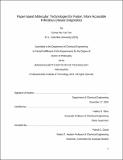Paper-based Molecular Technologies for Faster, More Accessible Infectious Disease Diagnostics
Author(s)
Yee, Emma Hiu-Yan
DownloadThesis PDF (7.851Mb)
Advisor
Sikes, Hadley D.
Terms of use
Metadata
Show full item recordAbstract
A lack of rapid, widely accessible methods for diagnosing infectious diseases greatly hinders effective disease control in all parts of the world, but especially in resource-limited communities. Resource-limited areas frequently are the hardest hit by infectious diseases, but often cannot support the cost and infrastructure needs of current diagnostic methods. Technologies that utilize low-cost materials and easy-to-use methods could help address this issue. Diagnostic tests made from cellulose paper that use colorimetric readouts—where a visible color appears if disease biomarkers are present—have shown promise in reducing device cost, equipment and training needs. However, their ability to support a variety of diagnostic methods has not been extensively assessed. The objective of this thesis was to investigate the ability of paper-based, colorimetric diagnostic tests to detect protein and nucleic acid biomarkers of infectious disease in clinically relevant matrices.
Protein affinity reagents, such as antibodies and engineered binder proteins, were integrated into paper devices, and antibody stabilization methods were developed for room-temperature bioactive paper device storage. It was demonstrated that paper-based tests with colorimetric detection methods could detect both protein and DNA infectious disease biomarkers in complex, bodily fluids like saliva. Colorimetric detection was performed either via enzymatic amplification or eosin photopolymerization amplification, a visible light-initiated radical polymerization method for colorimetric signal amplification in diagnostic assays. To better understand the eosin photopolymerization reaction mechanism and its diagnostic applications, a reaction-diffusion model that closely mimicked paper diagnostic assay conditions was developed based on a proposed reaction mechanism. After experimental validation, the model and experimental results were used to inform future use of the colorimetric signal amplification method.
Investigating the diagnostic performance of paper-based colorimetric tests enabled the development of diagnostic assays with clinically relevant sensitivity for tuberculosis, periodontal disease, and COVID-19. Cellulose paper microfluidic devices were shown to be versatile platforms that can support different detection reactions and capture chemistries, and are compatible with many sample types. The main findings of this research have enabled a better understanding of how paper-based colorimetric diagnostic tests can be applied to better meet disease control needs.
Date issued
2021-02Department
Massachusetts Institute of Technology. Department of Chemical EngineeringPublisher
Massachusetts Institute of Technology